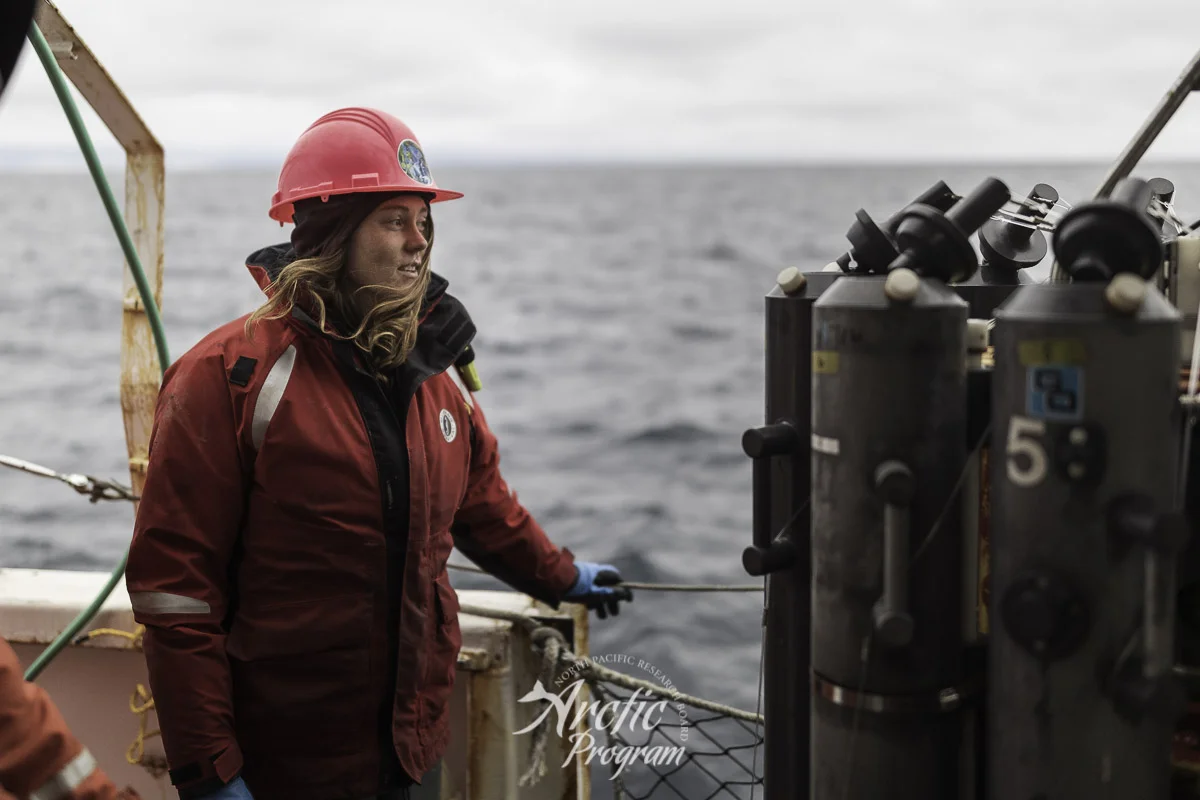We crossed into the realm of the Arctic Circle on August 10th, 2019 aboard the contract vessel Ocean Starr west of Kotzebue Sound at 66 degrees and 33 minutes north. This is my first time crossing the Arctic Circle. Maritime tradition marks this occasion with a secret ceremony and a certificate issued from “Neptunus Rex” which declares the recipient “to be a loyal and trusty salt-lined and brine-encrusted Bluenose” and calls upon “all Icebergs, Sea Lions, Narwhals, Polar Bears, Whales, Mermaids and other creatures of the Frigid North to show them due deference and respect.” As we crossed, the sea and sky reflected one another in the same muted grey hue we had been steaming through since we left Nome. Shearwaters and gulls were sparse. Earlier near Saint Lawrence Island we spotted a dead walrus with its skin rotted off; a floating white marshmallowy blubber-mass. We gawped at it as it floated past, then hustled back to work on the aft deck to drag up a mooring that wasn’t responding to its acoustic release code.
Sarah Donohoe looks off to the horizon before the CTD rosette is deployed. Photo credit: Brendan Smith/NPRB
We watched, tense, as the cable dragged three large hooks along the bottom and Dave Strausz (Pacific Marine Environmental Lab, PMEL) and Catherine Berchock (Alaska Fisheries Science Center, AFSC) ran the hydraulic winch to wind the cable back onto the drum. Dragging for a mooring is a last-resort operation that comes with increased risk: the ship may snag a hook on a pinnacle and get stuck, spear the hook through a delicate and expensive oceanographic instrument, or catch the mooring upside down and drag up a 1200-lb anchor for the mooring technicians to contend with. When you drag hooks along the sea floor you can never be certain of what’s about to happen. Risk cannot be eliminated from oceanographic research, only managed with caution, hard-hats, steel-toed shoes and float coats.
Scientist Dave Strauss guiding the dragging wire for a missing mooring buoy. Photo credit: Brendan Smith/NPRB
We tallied the blue and yellow markings on the cable as they wound back in, 120 meters left… visible tension in the cable, we had something! 40 meters left… then the cable bounced and the hooks broke the surface, empty. Dave and Pete Shipton (University of Alaska Fairbanks, UAF) groaned in unison with disappointment.
“We have time, let’s try again” Ryan McCabe (University of Washington, UW) made the radio call to the bridge, directing our steps.
We began the maneuver over, starting with verifying the mooring’s location by lowering the transducer into the water and sending “pings” to the acoustic release. Chirps returned and reverberated on the steel hull of the Ocean Starr as if we were hunting submarines. Pete had one ear to a headset and both eyes locked on the deck unit digital readout. “Range: 320 meters," Pete turned and relayed the distance into his radio for the bridge.
By repeatedly marking the location of the ship and the distance to the mooring, the ship’s bridge officer can triangulate the position of the mooring on the electronic navigation system. “Looks like you moved it on that first drag, even if you didn’t get it up to the surface.” The Chief Mate’s voice crackled over the VHF, “It’s about 150 meters from our last marked position.”
Pete’s eyes grew slightly wider and more hopeful, “Well, that’s something.” Pete retried the release code, to no avail. Dave and Catherine resumed their posts at the dragging winch, Pete gave the signal, and the ship began to lay out the hooks and cable in a circle over the mooring position for the second time.
Catherine Berchok guiding the dragging wire back into the spool of the winch. Photo credit: Brendan Smith/NPRB
Fifteen minutes later, sufficient cable had been laid, and the ship stopped turning a constant circle. “Hauling back now” Dave intoned. Catherine kept an eagle eye on the blue and yellow marks rolling back along the length of the cable, counting down, “300 meters to go”. There was visible tension in the cable again. Suddenly, the cable sagged and then snapped tight, only to go slack again.
In the time it took for me to take a breath in preparation for a dejected sigh, a yellow float bobbed up to the surface with a halo of bubbles 30 meters off our starboard quarter. I let out an involuntary cheer instead! “Neptunus Rex” must have taken pity on us. I gave another cheer, the ship maneuvered to put the float close on the port side. We worked as a team to hook the mooring float to the crane and bring it all safely aboard.
Chief Scientist Ryan McCabe takes a short break to joke with Pete Shipton (off-camera) after a long day of research operations. Photo credit: Brendan Smith/NPRB
Once on deck, our original trouble with the unresponsive release became evident: a large barnacle had grown in the crevice where the acoustic release arm should have been able to drop freely. The barnacle had jammed the release! Our drag hooks were able to pull just enough to break off the stubborn barnacle and free the mooring. The float, chain, release and attached oceanographic instruments storing a years’ worth of valuable data were all recovered intact! Dragging operations are always risky, but also often rewarding.





